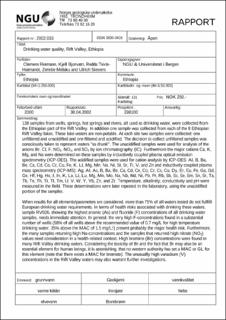| dc.description.abstract | 138 samples from wells, springs, hot springs and rivers, all used as drinking water, were collected from the Ethiopian part of the Rift Valley. In addition one sample was collected from each of the 8 Ethiopian Rift valley lakes. These lake waters are non-potable. At each site two samples were collected: one unfiltered and unacidified and one filtered and acidified. The decision to collect unfiltered samples was consciously taken to represent waters \"as drunk\". The unacidified samples were used for analysis of the anions Br, Cl, F, No2, No3 and So4 by ion chromatography (IC). Furthermore the major cations Ca, K, Mg, and Na were determined on these samples by inductively coupled plasma optical emission spectrometry (ICP-OES). The acidified samples were used for cation analysis by ICP-OES: Al, B, Ba, Be, Ca, Cd, Co, Cr, Cu, Fe, K, Li, Mg, Mn, Na, Ni, Si, Sr, Ti, V, and Zn and inductively coupled plasma mass spectrometry (ICP-MS): Agh, Al, As, B, Ba, Be, Ca, Cd, Ce, Co, Cr, Cs, Cu, Dy, Er, Eu, Fe, Ga, Gd, Ge, Hf, Hg, Ho, I, In, K, La, Li, Lu, Mg, Mn, Mo, Na, Nb, Nd, Ni, Pb, Pr, Rb, Sb, Sc, Se, Sm, Sn, Sr, ta, Tb, Te, Th, Ti, Tl, Tm, U, V, W, Y, Yb, Zn, and Zr. Temperature, alkalinity, conductivity and pH were measured in the field. These determinations were later repeated in the laboratory, using the unacidified portion of the samples. When results for all elements\/parameters are considered, more than 75% of all waters tested do not fulfill European drinking water requirements. In terms of health risks associated with drinking these waters, sample RV026, showing the highest arsenic (As) and fluoride (F) concentrations of all drinking water samples, needs immediate attention. In general, the very high F-concentrations found in a substantial number of wells (58% of all wells above the recommended value of 0.7 mg\/L for high temperature drinking water, 35% above the MAC of 1.5 | |

